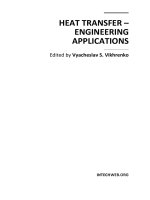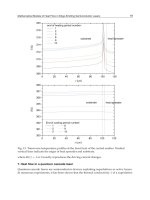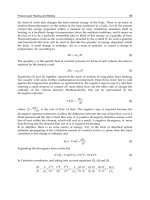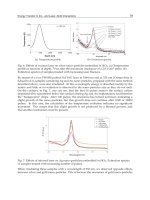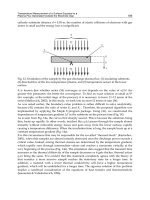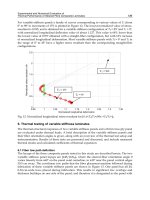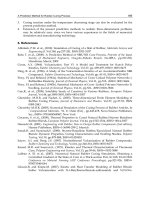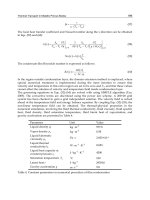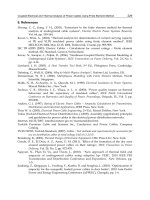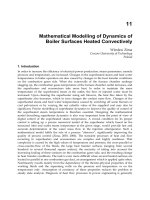HEAT TRANSFER ENGINEERING APPLICATIONS
Bạn đang xem bản rút gọn của tài liệu. Xem và tải ngay bản đầy đủ của tài liệu tại đây (25.46 MB, 412 trang )
HEAT TRANSFER –
ENGINEERING
APPLICATIONS
Edited by Vyacheslav S. Vikhrenko
Heat Transfer
–
Engineering Applications
Edited by Vyacheslav S. Vikhrenko
Published by InTech
Janeza Trdine 9, 51000 Rijeka, Croatia
Copyright © 2011 InTech
All chapters are Open Access distributed under the Creative Commons Attribution 3.0
license, which allows users to download, copy and build upon published articles even for
commercial purposes, as long as the author and publisher are properly credited, which
ensures maximum dissemination and a wider impact of our publications. After this work
has been published by InTech, authors have the right to republish it, in whole or part, in
any publication of which they are the author, and to make other personal use of the
work. Any republication, referencing or personal use of the work must explicitly identify
the original source.
As for readers, this license allows users to download, copy and build upon published
chapters even for commercial purposes, as long as the author and publisher are properly
credited, which ensures maximum dissemination and a wider impact of our publications.
Notice
Statements and opinions expressed in the chapters are these of the individual contributors
and not necessarily those of the editors or publisher. No responsibility is accepted for the
accuracy of information contained in the published chapters. The publisher assumes no
responsibility for any damage or injury to persons or property arising out of the use of any
materials, instructions, methods or ideas contained in the book.
Publishing Process Manager Bojan Rafaj
Technical Editor Teodora Smiljanic
Cover Designer InTech Design Team
Image Copyright evv, 2010. Used under license from Shutterstock.com
First published November, 2011
Printed in Croatia
A free online edition of this book is available at www.intechopen.com
Additional hard copies can be obtained from
Heat Transfer – Engineering Applications, Edited by Vyacheslav S. Vikhrenko
p. cm.
ISBN 978-953-307-361-3
free online editions of InTech
Books and Journals can be found at
www.intechopen.com
Contents
Preface IX
Part 1 Laser-, Plasma- and Ion-Solid Interaction 1
Chapter 1 Mathematical Models of Heat Flow in
Edge-Emitting Semiconductor Lasers 3
Michał Szymanski
Chapter 2 Temperature Rise of Silicon Due to Absorption
of Permeable Pulse Laser 29
Etsuji Ohmura
Chapter 3 Pulsed Laser Heating and Melting 47
David Sands
Chapter 4 Energy Transfer in Ion– and Laser–Solid Interactions 71
Alejandro Crespo-Sosa
Chapter 5 Temperature Measurement of a Surface
Exposed to a Plasma Flux Generated
Outside the Electrode Gap 87
Nikolay Kazanskiy and Vsevolod Kolpakov
Part 2 Heat Conduction – Engineering Applications 119
Chapter 6 Experimental and Numerical Evaluation of
Thermal Performance of Steered Fibre
Composite Laminates 121
Z. Gürdal, G. Abdelal and K.C. Wu
Chapter 7 A Prediction Model for Rubber Curing Process 151
Shigeru Nozu, Hiroaki Tsuji and Kenji Onishi
Chapter 8 Thermal Transport in Metallic Porous Media 171
Z.G. Qu, H.J. Xu, T.S. Wang, W.Q. Tao and T.J. Lu
VI Contents
Chapter 9 Coupled Electrical and Thermal Analysis of Power Cables
Using Finite Element Method 205
Murat Karahan and Özcan Kalenderli
Chapter 10 Heat Conduction for Helical and Periodical
Contact in a Mine Hoist 231
Yu-xing Peng, Zhen-cai Zhu and Guo-an Chen
Chapter 11 Mathematical Modelling of Dynamics of Boiler
Surfaces Heated Convectively 259
Wiesław Zima
Chapter 12 Unsteady Heat Conduction Phenomena in
Internal Combustion Engine Chamber and
Exhaust Manifold Surfaces 283
G.C. Mavropoulos
Chapter 13 Ultrahigh Strength Steel: Development of Mechanical
Properties Through Controlled Cooling 309
S. K. Maity and R. Kawalla
Part 3 Air Cooling of Electronic Devices 337
Chapter 14 Air Cooling Module Applications to
Consumer-Electronic Products 339
Jung-Chang Wang and Sih-Li Chen
Chapter 15 Design of Electronic Equipment Casings for Natural
Air Cooling: Effects of Height and Size of Outlet
Vent on Flow Resistance 367
Masaru Ishizuka and Tomoyuki Hatakeyama
Chapter 16 Multi-Core CPU Air Cooling 377
M. A. Elsawaf, A. L. Elshafei and H. A. H. Fahmy
Preface
Enormous number of books, reviews and original papers concerning engineering
applications of heat transfer has already been published and numerous new
publications appear every year due to exceptionally wide list of objects and processes
that require to be considered with a view to thermal energy redistribution. All the
three mechanisms of heat transfer (conduction, convection and radiation) contribute to
energy redistribution, however frequently the dominant mechanism can be singled
out. On the other hand, in many cases other phenomena accompany heat conduction
and interdisciplinary knowledge has to be brought into use. Although this book is
mainly related to heat transfer, it consists of a considerable amount of interdisciplinary
chapters.
The book is comprised of 16 chapters divided in three sections. The first section
includes five chapters that discuss heat effects due to laser-, ion-, and plasma-solid
interaction.
In eight chapters of the second section engineering applications of heat conduction
equations are considered. In two first chapters of this section the curing reaction
kinetics in manufacturing process for composite laminates (Chapter 6) and rubber
articles (Chapter 7) is accounted for. Heat conduction equations are combined with
mass transport (Chapter 8) and ohmic and dielectric losses (Chapter 9) for studying
heat effects in metallic porous media and power cables, respectively. Chapter 10 is
devoted to analysing the safety of mine hoist under influence of heat produced by
mechanical friction. Heat transfer in boilers and internal combustion engine chambers
are considered in Chapters 11 and 12. In the last Chapter 13 of this section temperature
management for ultrahigh strength steel manufacturing is described.
Three chapters of the last section are devoted to air cooling of electronic devices. In the
first chapter of this section it is shown how an air-cooling thermal module is
comprised with single heat sink, two-phase flow heat transfer modules with high heat
transfer efficiency, to effectively reduce the temperature of consumer-electronic
products such as personal computers, note books, servers and LED lighting lamps of
small area and high power. Effects of the size and the location of outlet vent as well as
the relative distance from the outlet vent location to the power heater position of
electronic equipment on the cooling efficiency is investigated experimentally in
X Preface
Chapter 15. The last chapter objective is to minimize air cooling limitation effect and
ensure stable CPU utilization using dynamic thermal management controller based on
fuzzy logic control.
Dr. Prof. Vyacheslav S. Vikhrenko
Belarusian State Technological University,
Belarus
Part 1
Laser-, Plasma- and Ion-Solid Interaction
0
Mathematical Models of Heat Flow
in Edge-Emitting Semiconductor
Lasers
Michał Szyma´nski
Institute of Electron Technology
Poland
1. Introduction
Edge-emitting lasers started the era of semiconductor lasers and have existed up to
nowadays, ap pearing as devices fabricated out of various materials, formed sometimes in
very tricky ways to enhance light generation. However, in all cases radiative processes
are accompanied by undesired heat-generating p r ocesses, like non-radiative recombination,
Auger recombination, Joule effect or surface recombination. Even for highly efficient laser
sources, great amount of energy supplied by pumping current is converted into heat.
High temperature leads to deterioration of the main laser parameters, like threshold current,
output power, spectral characteristics or lifetime. In some cases, it may result in irreversible
destruction o f the device via catastrophic optical damage ( COD) of the mirrors. Therefore,
deep insight into thermal effects is required while designing the improved devices.
From the thermal point of view, the laser chip (of dimensions of 1-2 mm or less) is a rectangular
stack of layers of different thickness and thermal properties. This stack is fixed to a slightly
larger heat spreader, which, in turn, is fixed to the huge heat-sink (of dimensions of several
cm), transferring heat to air by convection or cooled by liquid or Peltier cooler. Schematic view
of the assembly is shown in Fig. 1. Complexity and large size differences between the elements
often induce such s implifications like reduction of the dimensionality of equations, thermal
scheme geometry modifications or using non-uniform m esh in numerical calculations.
Mathematical models of heat flow in edge-emitting lasers are based on the heat conduction
equation. In most cases, solving this equation provides a satisfactory picture of thermal
behaviour of the device. More precise approaches use in addition the carrier diffusion
equation. The most sophisticated thermal models take into consideration variable photon
density found by s olving photon rate equations.
The heat generated inside the chip is mainly removed by conduction and, in a minor degree,
by convection. Radiation can be neglected. Typical boundary conditions for heat conduction
equation are the following: isothermal condition at the bottom of the device, thermally
insulated side walls, convectively cooled upper surface. It must be said that obtaining reliable
temperature profiles is often impossible due to individual features of particular devices,
which are difficult to evaluate within the quantitative analysis. Mounting imperfections
1
2 Will-be-set-by-IN-TECH
Fig. 1. Schematic view of the laser chip or laser array mounted on the he at spreader and h eat
sink (not in scale).
like voids in the solder or overhang (the chip does not adhere to the heat-spreader entirely)
may significantly obstruct the heat transfer. Surface recombination, the main mirror heating
mechanism in bipolar devices, strongly depends on facet passivation.
Since quantum cascade lasers (QCL’s) exploit superlattices (SL’s) as active layers, they have
brought new challenges in the field of thermal modelling. Numerous experiments show that
the thermal c onductivity of a superlattice is significantly reduced. The phenomenon can
be explained in terms of phonon transport across a stratified medium. As a consequence,
mathematical models of heat flow in quantum cascade lasers resemble those created for
standard edge-emitting lasers, but the stratified active region is replaced by an equivalent
layer described by anisotropic thermal conductivity. In earlier works, the cross-plane and
in-plane values of this parameter were obtained by arbitrary reduction of bulk values or
treated as fitting parameters. Recently, some theoretical methods of assessing the thermal
conductivity of superlattices have been developed.
The present chapter is organised as follows. In sections 2, 3 and 4, one can find the description
of static thermal models from the simplest to the most complicated ones. Section 5 provides a
discussion of the non-standard boundary condition assumed at the upper surface. Dynamical
issues of thermal modelling are addressed in section 6, while section 7 is devoted to quantum
cascade lasers. In greater part, the chapter is a review based on the author’s research
supported by many other works. However, Fig. 7, 8, 12 and 13 present the unpublished
results dealing with facet temperature reduction techniques and dynamical thermal behaviour
of laser arrays. Note that section 8 is not only a short revision of the text, but contains
some additional information or considerations, which may be useful for thermal modelling
of edge-emitting lasers. The m ost important mathematical symbols are presented in Table 1.
Symbols of minor importance are described in the text just below the equations, in which they
appear.
4
Heat Transfer - Engineering Applications
Mathematical Models of Heat Flow in Edge-Emitting Semiconductor Lasers 3
Symbol Description
A
nr
non-radiative re combination coefficient
B bi-molecular recombination coefficient
b chip width (see Fig. 2)
C
A
Auger recombination coefficient
c
h
specific heat
D diffusion coefficient
d
n
total thickness of the n-th medium
g heat source function
I driving current
L resonator length
n
eff
effective refractive index
n
i
number of interfaces
N, N
tr
carrier concentration, transparency carrier concentration
R
f
, R
b
power reflectivity of the front and back mirror
r
Bd
(1 → 2) TBR for the heat flow from medium 1 to 2
S total photon density
S
f
, S
b
photon density of the forward and backward travelling wave
S
av
averaged photon density
t time
T temperature
T
up
temperature of the upper surface
V voltage
v
sur
surface recombination velocity
w contact width (see Fig. 2)
y
t
top of the structure (see Fig. 2)
x, y, z spatial coordinates (see Fig. 1)
α convection coefficient
α
gain
linear gain coefficient
α
int
internal loss within the active region
β spontaneous emission coupling coefficient
Γ confinement fa ctor
λ thermal conductivity
λ
⊥
,λ
thermal conductivity of QCL’s active layer in the direction
perpendicular and parallel to epitaxial layers, respectively
ν frequency
ρ
n
density, subscript n (if added) denotes the medium number
τ, τ
av
carrier lifetime, averaged carrier lifetime
c, e, h, k
B
physical constants: light velocity, elementary charge, Planck
and Boltzmann constants, respectively.
Table 1. List of symbols.
5
Mathematical Models of Heat Flow in Edge-Emitting Semiconductor Lasers
4 Will-be-set-by-IN-TECH
Fig. 2. Schematic view of a laser chip cross-section (A). Function describing the heat source
(B).
2. Models based on the heat conduction equation only
Basic thermal behaviour of an edge-emitting laser can be described by the stationary heat
conduction equation:
∇(λ(y)∇T(x, y)) = −g(x, y) (1)
accepting the following assumptions (see Fig. 2):
— the laser is a rectangular stack of layers of different thickness and thermal conductivities;
1
— there is no heat escape from the top and side walls, while the temperature of the bottom
of the structure is constant;
— the active layer is the o nly heat source in the structure and i t is represented by infinitely
thin stripe placed between the waveguide layers.
The heat power density is determined according to the crude approximation:
g
(x, y)=
VI − P
out
Lw
,(2)
which physically means that the difference between the total power supplied to the device
and the output power is uniformly distributed over the surface of the selected region.
2
The
problem was solved analytically by Joyce & Dixon (1975). Further works using this model
introduced convective cooling at the top of the laser, considered extension and diversity of
heat sources or changed the thermal scheme in order to take into account the non-ideal heat
sink (Bärwolff et al. (1995); Puchert et al. (1997); Szyma ´nski et al. (2007; 2004)). Such approach
allows to calculate temperature inside the resonator, whi le the te mperature in the vicinity of
1
Note that the thermal scheme can be easily generalised to laser array by periodic duplication of stack
along the x axis.
2
In a three-dimensional case the surface is replaced by the volume.
6
Heat Transfer - Engineering Applications
Mathematical Models of Heat Flow in Edge-Emitting Semiconductor Lasers 5
mirrors is reliable only in the ne ar-threshold regime. The work by Szyma´nski et al. (2007) can
be regarded as a recent version of this model and will be briefly described below.
Assuming no he at escape from the side walls:
∂
∂x
T
(±
b
2
, y
)=0(3)
and using the separation of variables approach (Bärwolff et al. (1995); Joyce & Dixon (1975)),
one obtains the solution for T in two-fold form. In the layers above the active layer (n -even)
temperature is described by
T
n
(x, y)=A
(0)
2K
(w
(0)
A,n
+ w
(0)
B,n
y)+
∞
∑
k=1
A
(k)
2K
[w
(k)
A,n
ex p(μ
k
y)+w
(k)
B,n
ex p(−μ
k
y)] cos(μ
k
x),(4)
while under the active layer (n - odd) it takes the form:
T
n
(x, y)=A
(0)
2M−1
(w
(0)
A,n
+ w
(0)
B,n
y)+
∞
∑
k=1
A
(k)
2M−1
[w
(k)
A,n
ex p(μ
k
y)+w
(k)
B,n
ex p(−μ
k
y)] cos(μ
k
x).(5)
In (4) and (5) μ
k
= 2k π/b is the separation constant and thus it appears i n both directions (x
and y). Integer number k numerates the he at modes. Coefficients w
(k)
A,n
and w
(k)
B,n
and relation
between A
(k)
2K
and A
(k)
2M−1
can be found in Szyma´nski (2007). They are determined by the
bottom boundary condition, continuity conditions for the temperature and heat flux at the
layer interfaces and the to p boundary condition.
Fig. 3. Thermal scheme modification. Assuming larger b allows to keep the rectangular
cross-section of the whole assembly and hence equations (4) and (5) can be used.
The results obtained according t o the model described above are presented in Table 2. The
calculated values are slightly underestimated due to bonding imperfections, which elude
7
Mathematical Models of Heat Flow in Edge-Emitting Semiconductor Lasers
6 Will-be-set-by-IN-TECH
Device number Heterostructure A Heterostructure B Heterostructure C
1 12.03/7.38 11.23/7.31 8.9/8.24
2 13.35/7.38 12.17/7.31 7.0/4.76
Table 2. Measured/calculated thermal resistances in K/W (Szyma ´nski et al. (2007)).
qualitative assessment. A similar problem was described in Manning (1981), where even
greater discrepancies between theory and experiment were obtained. For the properly
mounted device C1 excellent convergence is found.
Improving the accuracy of calculations was possible due to taking into account the finite
thermal conductivity of the heat sink material by thermal scheme modifications (see Fig. 3).
Assuming constant temperature at the chip-heat s preader interface leads to significant errors,
especially for p-side-down mounting (see Fig. 4).
The analytical approach presented above has been described in detail s ince it has been
developed by the author of this chapter. However, it should not be t reated as a favoured one.
In recent years, numerical methods seem to prevail. Pioneering works using Finite Element
Method (FEM) in the context of thermal investigations of edge-emitting lasers have been
described by Sarzała & Nakwaski (1990; 1994). Broader discussion of analytical vs. numerical
methods is presented in 8.3.
Fig. 4. Maximum temperature inside the laser for p-side down mounting. It is clear that the
assumption of ideal heat sink leads to a 50% error in calculations (Szyma ´nski et al. (2007)).
Thermal effects in the vicinity of the laser mirror are important because of possible COD
during high-power operation. Unfortunately, theoretical investigations of these processes,
using the heat conduction only, is rather difficult. There are two main mirror heating
mechanisms ( see Rinner et al. ( 2003)): surface recombination and optical absorption. W ithout
including additional equations, like those described in sections 3 and 4, assessing the heat
8
Heat Transfer - Engineering Applications
Mathematical Models of Heat Flow in Edge-Emitting Semiconductor Lasers 7
source functions may be problematic. An interesting theoretical approach dealing with mirror
heating and based on the heat conduction only, can be found in Nakwaski (1985; 1990).
However, both works consider the time-dependent picture, so they will be mentioned in
section 6.
3. Models including the diffusion equation
Generation of heat in a semiconductor laser occurs due to: (A) non-radiative recombination,
(B) Auger recombination, (C) Joule effect, (D) spontaneous radiative transfer, (E) optical
absorption and (F) surface recombination. The effects (A)—(C) and (E,F) are discussed in
standard textbooks (see Diehl (2000) or Piprek (2003)). Additional interesting information
about mirror heating mechanisms (E,F) can be found in Rinner et al. (2003). The effect (D) will
be briefly described below.
Apart from stimulated radiation, the laser active layer is a source of spontaneous radiation.
The photons emitted in this way propagate isotropically in all directions. They penetrate
the wide-gap layers and are absorbed in narrow-gap layers (cap or substrate) creating the
additional heat sources (see Nakwaski (1979)). Temperature calculations by Nakwaski (1983a)
showed that the considered effect is comparable to Joule heating in the near-threshold regime.
On the other hand, it is k nown that below the threshold spontaneous emission grows with
pumping current and saturates above the threshold. Thus, the radiative transfer may be
recognised as a minor effect and will be neglected in calculations presented in this chapter.
Note that processes (A)—(C) and (F) involve carriers, so g
(x, y, z) should be a carrier
dependent function. To avoid crude estimations, like equation (2), a method of getting to
know the carrier distribution in regions essential for thermal analysis is required.
3.1 Carrier distribution in the l aser active layer
An edge-emitting laser is a p-i-n diode operating under forward bias and in the plane of
junction the electric field is ne gligible. Therefore, the movement of the carriers is g overned
by diffusion. Bimolecular recombination and Auger process engage two and three carriers,
respectively. Such quantities like pumping or photon density are spatially inhomogeneous.
Far from the pumped region, the carrier concentration falls down to zero level. At the mirrors,
surface recombination occurs. Taking all these facts into account, one concludes that carrier
concentration in the active layer can be described by a nonlinear diffusion equation with
variable coefficients and mixed boundary conditions. Solving such an equation is really
difficult, but the problem can often be simplified to 1-dimensional cases. For example, if
problems of beam quality (divergence or filamentation) are discussed, considering the lateral
direction only is a good enough approach. In the case of a thermal problem, since surface
recombination is believed to be a very efficient facet heating mechanism responsible for COD,
considering the axial direction is required and the most useful form of the diffusion equation
can be written as
D
d
2
N
dz
2
−
c
n
eff
ΓG(N)S(z) −
N
τ
+
I
eV
= 0, (6)
where linear gain G
(N)=α
gain
(N − N
tr
) and non-linear carrier lifetime τ(N)=
(
A
nr
+ BN + C
A
N
2
)
−1
have been assumed. The surface recombination at the laser facets is
9
Mathematical Models of Heat Flow in Edge-Emitting Semiconductor Lasers
8 Will-be-set-by-IN-TECH
expressed through the boundary conditions:
D
dN
(0)
dz
= v
sur
N(0), D
dN
(L)
dz
= −v
sur
N(L).(7)
The p roblem of axial carrier concentration in the active layer of an edge-emitting laser was
investigated by Szyma´nski (2010). Three cases were considered:
(i) the nonlinear diffusion e quation with variable coefficients (equation (6) and boundary
conditions (7)) ;
(ii) the linear diffusion equation with constant coefficients derived form equation (6) by
assuming the averaged carrier lifetime τ
av
and averaged photon density S
av
;
(iii) the algebraic equation derived form equation (6) by neglecting the diffusion (D
= 0).
Fig. 5. Axial (mirror to mi rror) carrier concentration in the active layer calculated according
to algebraic equation (dotted line), linear diffusion equation with constant co efficients
(dashed line) and nonlinear diffusion equation with variable coefficients (solid
line) (Szyma´nski (2010)).
The results are shown in Fig. 5. It is clear that the approach (iii) yields a crude estimation of the
carrier concentration in the active layer. However, for thermal modelling, where phenomena
in the vicinity of facets are crucial due to possible COD processes, the diffusion equation
must be solved. In many works (see for example Chen & Tien (1993), Schatz & Bethea
(1994), Mukherjee & McInerney (2007)), the approach (ii) is used. It seems to be a good
approximation for a typical edge-emitting laser, which is an almost axially homogeneous
device in the sense that the depression of the photon density does not vary too much or
temperature differences along the resonator are not so significant to dramatically change the
10
Heat Transfer - Engineering Applications
Mathematical Models of Heat Flow in Edge-Emitting Semiconductor Lasers 9
non-linear recombination terms B and C
A
. The approach (i) is useful in all the cases where the
above-mentioned ax ial homogeneity is perturbed. In particular, the approach is suitable for
edge-emitting lasers wi th modified regions close to facets. These modifications are meant to
achieve m irror temperature reduction through placing current blocking layers (Rinner et al.
(2003)), producing non-injected f acets (so called NIFs) (Piersci ´nska et al. (2007)) or generating
larger band gaps (Watanabe et al. (1995)).
3.2 Carrier-dependent heat source function
The knowledge of axial carrier concentration opens up the possibility to write the heat source
function more precisely compared to e quation (2), namely
g
(x, y, z)=g
a
(x, y, z)+g
J
(x, y, z) ,(8)
where the first term describes the heat generation in the active layer and the second - Joule
heating. According to Romo et al. (2003):
g
a
(x, y, z)=[(A
nr
+ C
A
N
2
(z))N(z)+
c
n
eff
α
int
S
av
+
μ
sur
N(z = 0)
d
sur
Π
sur
(z)]hνΠ
a
(x, y, z).(9)
The terms in the right hand side of equation (9) are related to non-radiative recombination,
Auger processes, absorption of laser radiation and surface recombination at the facets,
respectively. Assessing the value of S
av
was widely discussed by Szyma´nski (2010). The Π’s
are positioning functions:
Π
sur
(z)=
1, for 0
< z < d
sur
;
0, for z
> d
sur
,
(10)
expresses the assumption that the defects in the vicinity of the facets are uniformly distributed
within a distance d
sur
= 0.5μm from the facet surface (Nakwaski (1990); Romo et al. (2003)),
while Π
a
(x, y, z)=1forx, y, z within the active layer and Π
a
(x, y, z)=0elsewhere.
The effect of Joule he ating is strictly related to t he electrical resistance of a particular layer.
High values of this parameter are found in waveguide layers, substrate and p-doped cladding
due to the lack of doping, large thickness and low mobility of holes, respectively Szyma´nski et
al. (2004). Thus, it is reasonable to calculate the total Joule heat and assume that it is uniformly
generated in layers mentioned above of total volume V
hr
:
g
J
(x, y, z)=
I
2
R
s
V
hr
, (11)
where R
s
is the device series resistance.
3.3 Selected results
Axial (mirror to mirror) distribution of relative temperature
3
in the active layer of the
edge-emitting laser is shown in Fig. 6. It has been calculated numerically solving the
3
The temperature exceeding the ambient temperature.
11
Mathematical Models of Heat Flow in Edge-Emitting Semiconductor Lasers
10 Will-be-set-by-IN-TECH
Fig. 6. Axial (mirror to mi rror) distribution of relative temperature in the active layer.
Fig. 7. Axial distribution of carriers in the active layer for the laser with non-injected facets.
The inset shows the step-like pumping profile.
12
Heat Transfer - Engineering Applications
Mathematical Models of Heat Flow in Edge-Emitting Semiconductor Lasers 11
three-dimensional heat conduction equation.
4
Heat source has been inserted according
to (8)-(11), where N
(z) has been calculated analytically from the linear diffusion equation with
constant coefficients (approach (ii) from section 3.1). Fig. 6 is in qualitative ag reement with
plots presented by Chen & Tien (1993); Mukherjee & McInerney (2007); Romo et al. (2003),
where similar or more advanced models were used. Note that the temperature along the
resonator axis is almost constant, while it rises rapidly in the vicinity of the facets. The small
asymmetry is caused by the location of the laser chip: the front facet is over the edge of the
heat s ink, so the heat removal is obstructed.
Facet temperature reduction techniques are often based on the idea of suppressing the
surface recombination by preventing the current flow in the v icinity of facets. It can be
realised by placing current blocking layers (Rinner et al. (2003)) or producing non-injected
facets (so called NIFs) (Piersci ´nska et al. (2007)). To investigate such devices the author
has solved the equation (6) numerically
5
inserting step-like function I(z).Fig.7shows
that, in the non-injected region, the carrier co ncentration rapidly decreases to values lower
than transparency level, which is an undesired effect and may disturb laser operation. A
solution to this problem, although technologically difficult, can be producing a device with
segmented contact. E ven weak pumping near the mirror drastically reduces the length o f the
non-transparent region, which is illustrated in Fig. 8.
Fig. 8. Axial distribution of carriers in the active layer for the l aser with non- and
weakly-pumped near-facet region. The inset shows the pumping profile for both cases.
4
Calculations have been done by Zenon Gniazdowski using the commercial software CFDRC
( />5
The commercial software FlexPDE ( has been used.
13
Mathematical Models of Heat Flow in Edge-Emitting Semiconductor Lasers
